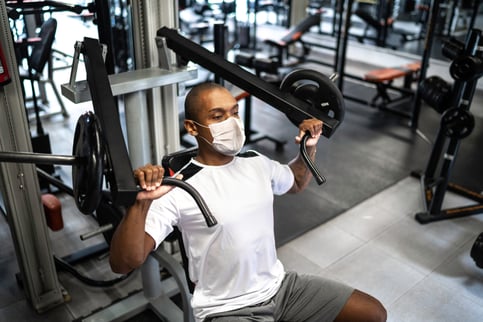 Are your fitness and wellness programs reaching your residents, but now you’re wondering how to take your community’s reputation to the next level by demonstrating an even bigger commitment to a healthy, active lifestyle campus-wide? Perhaps it’s time to incorporate a staff component into some of your resident fitness and wellness initiatives! There are several benefits of employees participating in challenges or broader wellness initiatives with residents in your community settings, here are the top 5!
Are your fitness and wellness programs reaching your residents, but now you’re wondering how to take your community’s reputation to the next level by demonstrating an even bigger commitment to a healthy, active lifestyle campus-wide? Perhaps it’s time to incorporate a staff component into some of your resident fitness and wellness initiatives! There are several benefits of employees participating in challenges or broader wellness initiatives with residents in your community settings, here are the top 5!
- Improved Health and Wellness: Regular physical activity is not only beneficial for your residents, but for everyone! By participating in resident fitness and wellness challenges employees too can maintain a healthy weight, reduce their risk of disease, improve their strength, flexibility, and cardiovascular health, and improve their overall health and well-being. By participating alongside residents, they’re also more likely to stick to their goals as they become role models, supporters, and more accountable.
- Team Building: You want a strong collaborative team leading of employees leading the way at your community, right? By including employees into fitness and wellness challenges and encouraging them to work together towards a common goal, you’ll be fostering team building, collaborative programming, communication, and a sense of community which can be beneficial for them in all aspects of their lives, including at work.
- Enhanced Job Satisfaction: When employees can participate in activities which promote better well-being, they’re likely to experience increased energy levels, decreased stress, improved mood and greater job satisfaction. Increased job satisfaction and morale can lead to greater productivity, and increased employee retention!
- Positive Impact of Resident Experience: Participating in a challenge alongside one another can foster positive relationships between employees and residents. This provides them with the ability to build rapport with each other and leads to better communication, and enhanced employee-resident interactions. When your residents see that the employees are engaged and committed to healthy habits through participation more residents may be inclined to join in as well, which can improve their health and fitness outcomes and enhance their overall quality of life.
- Positive Reputation and Retention: By demonstrating a commitment to employee health and well-being, while continuing to promote vibrant lifestyle options for your residents, you will be more apt to attract and retain not only residents, but also a top performing team!
If you wish to have a productive workplace environment and retain top talent, we urge you to open some aspect of your community-wide wellness initiatives to your employees.


.jpg?width=396&height=264&name=GettyImages-1354842116%20(1).jpg) The NIFS staff often find that employees will take time away from their desk to exercise, enjoy conversation that isn't work related, or simply decompress. Our staff are great at putting the FUN into Fitness which often results in laughter during classes, conversations and that sense of community in our client's onsite fitness centers.
The NIFS staff often find that employees will take time away from their desk to exercise, enjoy conversation that isn't work related, or simply decompress. Our staff are great at putting the FUN into Fitness which often results in laughter during classes, conversations and that sense of community in our client's onsite fitness centers.
.jpg?width=455&height=303&name=GettyImages-516160511%20(1).jpg) Gratitude is the quality of being thankful. It is showing appreciation for giving and receiving acts of kindness. Performing acts of kindness has many benefits to our health, both mentally and physically. When we practice gratitude, we improve our daily wellbeing and overall happiness. Gratitude helps us with our mindset. We learn how to be more positive and be kinder to ourselves and others. We want to treat other people the way we want to be treated. This increases everyone’s sense of happiness which in return improves our health.
Gratitude is the quality of being thankful. It is showing appreciation for giving and receiving acts of kindness. Performing acts of kindness has many benefits to our health, both mentally and physically. When we practice gratitude, we improve our daily wellbeing and overall happiness. Gratitude helps us with our mindset. We learn how to be more positive and be kinder to ourselves and others. We want to treat other people the way we want to be treated. This increases everyone’s sense of happiness which in return improves our health. Do you drink enough water throughout the day? The body and all of the systems in it require a certain level of water to preform everyday activities. Staying hydrated can help move waste out, maintain a normal body temperature, and cushion your joints. Here are six tips to make sure you stay hydrated throughout the day.
Do you drink enough water throughout the day? The body and all of the systems in it require a certain level of water to preform everyday activities. Staying hydrated can help move waste out, maintain a normal body temperature, and cushion your joints. Here are six tips to make sure you stay hydrated throughout the day.  Mental health has been a growing topic of conversation over the last few years, and for good reason. The first step of mental health awareness is being comfortable enough to talk about it. This topic is no longer taboo, and people are learning to prioritize their mental health. According to the CDC, “Mental health includes our emotional, psychological, and social well-being. It affects how we think, feel, and act.” Mental illness effects millions of people in the U.S. each year. It’s important to measure how common mental illness is so that we can recognize that no one is alone in their battles.
Mental health has been a growing topic of conversation over the last few years, and for good reason. The first step of mental health awareness is being comfortable enough to talk about it. This topic is no longer taboo, and people are learning to prioritize their mental health. According to the CDC, “Mental health includes our emotional, psychological, and social well-being. It affects how we think, feel, and act.” Mental illness effects millions of people in the U.S. each year. It’s important to measure how common mental illness is so that we can recognize that no one is alone in their battles. Taking advantage of the benefits nature has to offer, I step outside and take a deep breath of fresh air to begin my walk. Big inhale… slow exhale, “ahhhhh…so relax…” sudden coughing interrupts… “hmm the air seems a little thick today. Not quite the relaxing deep breath I was hoping for,” I shrug it off and continue on my way. But should I simply just dismiss it? The answer is, I don’t know until I check the condition of the air quality.
Taking advantage of the benefits nature has to offer, I step outside and take a deep breath of fresh air to begin my walk. Big inhale… slow exhale, “ahhhhh…so relax…” sudden coughing interrupts… “hmm the air seems a little thick today. Not quite the relaxing deep breath I was hoping for,” I shrug it off and continue on my way. But should I simply just dismiss it? The answer is, I don’t know until I check the condition of the air quality.
 As organizations are planning to reopen their offices in the weeks and months ahead, many questions are swirling around what the new office landscape will look like for both employers and employees. Some organizations are telling their employees if they can work from home full-time, they’d like for them to continue doing so permanently. Others can’t wait to return to normal office operations while also recognizing a hybrid telecommuting model will likely be the outcome.
As organizations are planning to reopen their offices in the weeks and months ahead, many questions are swirling around what the new office landscape will look like for both employers and employees. Some organizations are telling their employees if they can work from home full-time, they’d like for them to continue doing so permanently. Others can’t wait to return to normal office operations while also recognizing a hybrid telecommuting model will likely be the outcome. .jpg?width=434&name=GettyImages-1215677044%20(1).jpg) While many may have feelings of uncertainty come to mind with everything we’ve endured thus far in 2020, we’ve also experienced inspiration from the dedication of our healthcare workers and educators and witnessed innovation in how many industries are adapting to remote workforces and revised service models.
While many may have feelings of uncertainty come to mind with everything we’ve endured thus far in 2020, we’ve also experienced inspiration from the dedication of our healthcare workers and educators and witnessed innovation in how many industries are adapting to remote workforces and revised service models.
 I wrote a post a while ago about
I wrote a post a while ago about 
.jpg?width=640&name=Coloring%20book%20GettyImages-510075730%20(1).jpg)